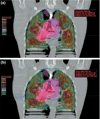Functional and molecular image guidance in radiotherapy treatment planning optimization
- PMID: 21356479
- PMCID: PMC3062208
- DOI: 10.1016/j.semradonc.2010.10.002
Functional and molecular image guidance in radiotherapy treatment planning optimization
Abstract
Functional and molecular imaging techniques are increasingly being developed and used to quantitatively map the spatial distribution of parameters, such as metabolism, proliferation, hypoxia, perfusion, and ventilation, onto anatomically imaged normal organs and tumor. In radiotherapy optimization, these imaging modalities offer the promise of increased dose sparing to high-functioning subregions of normal organs or dose escalation to selected subregions of the tumor as well as the potential to adapt radiotherapy to functional changes that occur during the course of treatment. The practical use of functional/molecular imaging in radiotherapy optimization must take into cautious consideration several factors whose influences are still not clearly quantified or well understood including patient positioning differences between the planning computed tomography and functional/molecular imaging sessions, image reconstruction parameters and techniques, image registration, target/normal organ functional segmentation, the relationship governing the dose escalation/sparing warranted by the functional/molecular image intensity map, and radiotherapy-induced changes in the image intensity map over the course of treatment. The clinical benefit of functional/molecular image guidance in the form of improved local control or decreased normal organ toxicity has yet to be shown and awaits prospective clinical trials addressing this issue.
Copyright © 2011 Elsevier Inc. All rights reserved.
Figures




References
-
- Jaffray DA. Image-guided radiation therapy: from concept to practice. Semin Radiat Oncol. 2007;17 243-234. - PubMed
-
- Yan D. Adaptive radiotherapy: merging principle into clinical practice. Semin Radiat Oncol. 2010;20:79–83. - PubMed
-
- Evans ES, Hahn CA, Kocak Z. The role of functional imaging in the diagnosis and management of late normal tissue injury. Semin Radiat Oncol. 2007;17:72–80. - PubMed
-
- Belkacemi Y, Tsoutsou P, Magne N. Metabolic functional imaging for tumor radiosensitivity monitoring. Crit Rev Oncol Hematol. 2007;62:227–239. - PubMed
Publication types
MeSH terms
Grants and funding
LinkOut - more resources
Full Text Sources

